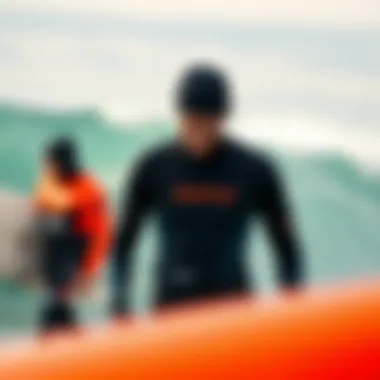Choosing the Best Wetsuit for Your Water Adventures


Intro
Selecting the right wetsuit can be a game changer for anyone looking to dive into the deep blue, catch a wave, or simply enjoy water sports. There’s a ton of varieties out there — it can leave you scratching your head. Not just about which color looks snazzy, but also about fit, material, and thickness, amongst other factors. In this guide, we aim to break it all down for you. You’ll learn how to pick the perfect wetsuit that meets your needs and makes your time in the water comfortable and enjoyable.
The world of water sports, from surfing to scuba diving, has evolved tremendously. As participants seek new thrills in various conditions, they're faced with an array of options when it comes to gear. Wetsuits serve a fundamental role in safeguarding against the elements, allowing adventurers to push their limits.
Let’s not kid ourselves; choosing a wetsuit is not just a fashion statement, but a practical decision. Depending on your activities and the climate, what works for one person may not work for another. Whether you’re a novice or a seasoned pro, understanding the nuances of wetsuit selection is essential.
As we dive deeper, we’ll touch on the essential aspects of wetsuit selection— the mechanics of fit, the types of materials available, the significance of thickness, and the special considerations based on your intended water activities. Armed with this knowledge, you can confidently navigate the bustling marketplace and find the suit that checks all the boxes for you.
Now, let�’s talk gear and equipment, starting with the heart of every surfer’s experience.
Understanding Wetsuits
When you consider spending time in chilly waters, selecting the right wetsuit is crucial. Understanding wetsuits not only helps you make an informed decision but also enhances your experience in water activities. This section delves into the essentials of what a wetsuit is, how they function, and the different types available. Knowing these elements can mean the difference between a pleasurable outing and an uncomfortable one.
What is a Wetsuit?
A wetsuit is a specialized garment designed predominantly for aquatic activities such as surfing, diving, and kayaking. It's crafted from a synthetic rubber material called neoprene, which provides insulation, buoyancy, and protection from abrasions. In essence, wetsuits are all about maintaining body warmth while being submerged in cool water. One might say they’re like a second skin that helps you stay cozy in the depths of the ocean.
How Wetsuits Work
Understanding how wetsuits work is fundamental for choosing the right one. When you put on a wetsuit, it clings tightly to your body. This snug fit is integral because it minimizes the amount of water that can flow in and out. Here's how it operates:
- Insulation: Wetsuits trap a thin layer of water between the suit and your skin. As your body heats this water, it forms a barrier that helps keep you warm.
- Buoyancy: The neoprene material offers buoyancy which assists in keeping you afloat without excessive effort.
- Protection: Besides thermal insulation, wetsuits shield against cuts, scrapes, and stings from marine life.
Wetsuits function somewhat like a warm hug—they keep you warm and protected in an otherwise chilly environment.
Different Types of Wetsuits
The market is saturated with various types of wetsuits, each designed to cater to different activities and water conditions. Understanding these can help you select the most suitable option for yourself.
Full Wetsuits
Full wetsuits cover you from neck to ankles. Their primary characteristic is a thickness ranging from 2mm to 6mm, depending on the water temperature. These suits provide maximum warmth and flexibility, making them a favored choice among surfers and divers. The unique feature that sets full wetsuits apart is the inclusion of full-length sleeves and legs, which minimizes exposure to cold water.
This makes them beneficial for cold water activities, but they can be restrictive in warmer climates, which may not be ideal for everyone.
Spring Suits
Spring suits, or short wetsuits, are a go-to for warmer weather. They usually have short sleeves and either short or long legs. The key characteristic of spring suits is their lighter thickness, often around 2 to 3mm, which keeps you comfortable in milder waters. They're popular during the late spring and summer seasons.
A unique feature of spring suits is their flexibility. They allow for easy movement, making them excellent for activities like surfing where agility is paramount. However, in cooler waters, their insulating capabilities may not suffice.
Shorty Wetsuits
Shorty wetsuits, commonly known as shortys, feature short sleeves and shorts or above-the-knee coverage. They cater primarily to warmer waters and are designed for activities where full coverage isn't necessary. Their hallmark is the 2mm to 3mm thickness of neoprene, which offers a balance of warmth and flexibility.
What sets shorty wetsuits apart is their lightweight nature, making them a favorite among beginners or casual swimmers who may find full wetsuits too constricting. The downside? In cooler waters, they might leave you shivering.
Neoprene Tops
Neoprene tops serve as a versatile addition. These tops can be combined with board shorts or swim trunks for varied coverage. The primary characteristic here is that they come in various thicknesses, primarily around 1.5mm to 2mm. They're practical for layering and can be great for additional warmth during those unpredictable cooler water conditions.
A noteworthy feature of neoprene tops is their versatility; they can be used for various activities like paddleboarding or even as a base layer under a thicker wetsuit. However, they're less effective for keeping water from directly touching your skin, which might be a consideration if you’re diving into frigid waters.
Factors Influencing Wetsuit Selection
Selecting the ideal wetsuit goes beyond merely picking a design or color. Several crucial factors play a role in ensuring the wetsuit is optimally suited for your unique needs and preferences. Understanding these elements can greatly enhance your experience in the water, offering both comfort and performance. Whether you're a seasoned surfer or a casual kayaker, giving thought to factors like water temperature, the activity you plan to undertake, and the thickness of the wetsuit can save you from a world of discomfort and poor performance.
Water Temperature Considerations


When it comes to choosing a wetsuit, one of the most significant elements is water temperature. The range of temperatures in your local surf or dive spots can vary greatly throughout the seasons, and wearing the right wetsuit is vital to staying warm or cool enough.
- A thick wetsuit may be essential in chilly waters, while a thinner option may do wonders in warmer temperatures. If the water is downright frigid, think about a full wetsuit with plenty of insulation. This can keep you cozy, allowing for longer times spent in the sea without risking hypothermia.
- Conversely, in warmer waters, a shorty wetsuit or even a neoprene top might suffice, allowing more freedom of movement and helping you avoid overheating.
The key here? Always check local water temp forecasts. They can guide your choice and help you prepare for a surprisingly cold dip or a sweltering outing.
Activity Type
Every water sport has its own unique footprint, so to speak. The activity you choose will heavily influence the characteristics of the wetsuit you need. Briefly, let’s dive into three popular activities that deserve further scrutiny:
Surfing
Surfing often requires flexibility and durability. When you're out catching waves, you need a wetsuit that doesn’t restrict your movements. This is where the design specifics come into play. An advantage of surfing wetsuits is that they often provide features seen in high-performance gear while maintaining warmth.
- A key characteristic is the seamless design, which allows for greater freedom while paddling. One major benefit of this is that it helps you stay in the zone when riding those killer waves, rather than battling against the suit itself.
- On the flip side, certain surf environments may demand thicker suits, which, while cozy, could limit movement slightly. But with a tailored fit, this downside can be minimized.
Scuba Diving
Diving into the depths presents a different challenge. In scuba diving, the insulating properties of a wetsuit become incredibly crucial as water temperatures can be deceivingly low just below the surface. A thick wetsuit is your best bet here for down deeper explorations.
- A standout feature for dive suits is the added insulation in specific areas, which helps especially for extended stays underwater, combating the chill effectively. A common drawback, however, is the bulkiness, which could restrict your movements while navigating underwater.
Kayaking
For kayaking, you’ll want a suit that allows for movement without sacrificing warmth. The design focuses on flexibility to keep those arms moving freely as you row against the currents.
- A quality wetsuit for kayaking should be lightweight and snug, offering just the right balance of warmth without excess bulk. This makes it easier to maneuver, enhancing overall performance on the water.
- However, those lightweight options might lack thicker insulation, which could be a disadvantage during cold weather excursions.
Thickness and Insulation
Finally, we land on thickness and insulation. This is the backbone of how long you can enjoy your water activity without feeling like a popsicle. The thickness of neoprene varies and should be chosen based on the conditions:
- 2mm to 3mm: Ideal for warm water conditions, providing a buffer against skin irritation, while not soaking up too much heat.
- 4mm to 5mm: More suited for cooler temperatures, these wetsuits keep you warm for longer durations.
- 5mm and above: Best for significantly cold waters, such as those experienced during winter surf sessions. This thickness adds bulk and may limit movement a tad but offers unparalleled protection against the cold.
Environmental factors, personal preferences, and specific activity requirements all play roles in your decision-making process. Finding the right balance can often seem overwhelming, but investing the time in understanding these elements will lead to a much more enjoyable experience in your chosen water sport.
Essential Features of High-Quality Wetsuits
Selecting the right wetsuit is about more than just looks or price. It's paramount to understand the essential features that contribute to the overall quality of a wetsuit. A well-constructed wetsuit can make all the difference in how comfortable and effective you are in the water. Knowing these features can guide you in making an informed decision tailored to your specific water activities.
Neoprene Quality
Neoprene is the backbone of any wetsuit, and its quality can significantly affect performance. High-quality neoprene provides superior insulation and flexibility, ensuring that you stay warm without sacrificing mobility. Cheaper wetsuits often use lower-grade neoprene that might feel stiff or chafe against your skin, ruining that perfect day on the waves.
When choosing a wetsuit, consider the thickness of the neoprene as well. Thicker neoprene provides better insulation suited for colder waters, while thinner options are ideal for warmer climates. High-end brands offer varying standards of neoprene, often enhanced with features like added buoyancy or reinforced areas for greater durability. The trade-off with thickness is always about flexibility and ease of movement, which is crucial for activities like surfing or diving.
Stitching and Seams
The details in stitching and seam construction are often ignored but are just as crucial as the neoprene itself. High-quality wetsuits use advanced stitching techniques such as glued and blind-stitched seams, which minimize water penetration and enhance durability. This type of stitching is ideal for maintaining warmth during those chilly ventures.
Furthermore, look for taped seams in premium models. This extra layer of protection not only improves the seam's strength but is also essential for preventing water from seeping in. A well stitched wetsuit can mean the difference between a joyful day and one filled with discomfort from cold water leaks.
"A properly constructed seam allows you to enjoy your time on the water, whereas a poorly stitched one can leave you feeling like a soaked sponge."
Fit and Comfort
Fit is indispensable when it comes to wetsuit performance. A snug fit prevents water from flushing in and out while allowing your body to maintain warmth. However, be careful; too tight can lead to restricted movement and discomfort, especially over extended periods. The best wetsuits often come with various sizes and cuts to accommodate different body shapes.
Consider the design elements—features like pre-bent knees, ankle cuffs, and adjustable collars offer added comfort and fit. These intricate details ensure that the wetsuit conforms to your body shape and allows flexibility where you need it most. Not to mention, many modern wetsuits also incorporate ergonomic designs that allow for greater maneuverability, making your time in the water less about battling your gear and more about enjoying your passion.
Top Recommended Wetsuit Brands


Choosing the right wetsuit is, without a doubt, a crucial step for anyone looking to dive into the waves or plunge into chilly waters. With so many brands on the market, understanding which ones stand out can save a lot of time and frustration. This section explores the top recommended wetsuit brands, focusing on their unique offerings and what makes them contenders for your next purchase.
Brand Profiles
O'Neill
O'Neill is a heavyweight in the wetsuit market and has made quite a name for itself since its inception. One of their most notable contributions is the invention of the "wetsuit" itself, dating back to the 1950s. Their commitment to innovation keeps them at the forefront of the industry.
An essential characteristic of O'Neill suits is their use of SuperStretch neoprene, which allows for greater flexibility while maintaining warmth. This feature is particularly valuable for surfers or divers who need quick movements without the suit feeling like a second skin. However, there are some who find O'Neill's pricing a tad on the higher end, but many believe it’s worth investing in quality.
Rip Curl
Rip Curl is synonymous with surfing culture and has earned its reputation by prioritizing quality and performance. Their suits often incorporate proprietary technologies, ensuring both warmth and comfort. One standout feature is their use of E4 neoprene, which is lighter and more stretchy compared to traditional materials.
Rip Curl also places heavy emphasis on fit, providing a range of styles to accommodate different body types. This might come at a slight cost, but many users rave about the comfort, which can make lengthy sessions in the water much more enjoyable.
Billabong
Billabong excels in striking the perfect balance between style and function. Their wetsuits are often recognized for their eye-catching designs, but don’t let the aesthetics fool you; the performance is commendable. Billabong suits feature AX2 Airlite neoprene, providing insulation without compromising movement.
For casual riders who appreciate a bit of flair, Billabong suits could be the ideal choice. The downside might be the insulation level; while great for warmer waters, they might not hold up as well in frigid conditions.
Xcel
Xcel has carved out a niche for itself by prioritizing innovation and sustainability. They offer a unique feature called ThermoCarbon, which is designed to trap heat effectively while reducing water entry.
As one of the top brands, Xcel is favored by many who face colder climates due to the superior warmth they provide. However, some wetsuit enthusiasts may find that their fit isn't as universally accommodating as others in the market; it’s crucial to try one on before making a decision.
Performance Evaluations
When evaluating wetsuits from these brands, it’s essential to consider how they perform in real-world conditions. Reviews on various platforms, including outdoor forums and dedicated surfing sites, provide insight into longevity, comfort, and overall suitability for specific activities.
Maintenance and Care for Wetsuits
Taking care of your wetsuit is not just a nice-to-have; it’s an essential part of ensuring it remains functional and comfortable for all your aquatic escapades. The right maintenance can prolong the life of your suit, keep it performing well, and even enhance your overall water experience. After all, a well-maintained wetsuit can be the difference between feeling restricted and achieving freedom in the water.
Proper Cleaning Techniques
Cleaning a wetsuit might seem straightforward, yet many enthusiasts overlook some crucial steps. When you’ve just spent hours in salty or chlorinated water, the first instinct might be to toss it in the washing machine and call it a day. However, this approach can do more harm than good. Here’s how to keep your wetsuit in tip-top shape:
- Rinse Immediately: As soon as you exit the water, give your wetsuit a thorough rinse with fresh water. This helps eliminate salt, sand, and any chemical residues.
- Gentle Hand Wash: Use your hands to clean the suit. A simple mix of cool water and mild soap will do wonders. Avoid any harsh detergents or bleach as they can degrade the neoprene.
- Avoid the Dryer: While the temptation to use a dryer can be strong, resist it. Always hang your wetsuit to dry in a shaded area, away from direct sunlight which can lead to fading and brittleness.
- Store It Right: After cleaning, make sure you hang your wetsuit inside out, as this aids in drying and minimizes the risk of mildew. A thick hanger is preferable to avoid misshaping the shoulders.
By following these steps, your wetsuit remains fresh and ready for action—not to mention, it smells better too.
“Taking care of your wetsuit is like nurturing a relationship. Neglect it, and it will fall apart; invest time and it rewards you abundantly.”
Storage Recommendations
How you store your wetsuit can significantly impact its longevity, just like how a photo must be stored properly to avoid fading. Incorrect storage can lead to creases, cracks, and a loss of elasticity. Here are some top tips for proper wetsuit storage:
- Avoid folding: Storing your wetsuit folded leads to unsightly creases. Always hang it up. A wide, padded hanger is your best bet for maintaining its shape.
- Cool, Dry Place: Choose a storage spot that’s cool and dry, avoiding areas exposed to direct sunlight or high heat. Over time, heat can break down neoprene and elastic fibers.
- Inspect Regularly: When it’s not in use, make it a habit to check your wetsuit for any signs of damage like punctures or worn areas. That way, you can address issues before they escalate.
- Keep Away From Pets: If you have pets, ensure they don’t have access to your wetsuit. Fur can get stuck in zippers and seams, and who knew a cat would treat a wetsuit like a plaything?
For more details on wetsuit care, check out resources at Wikipedia or dive into the conversations on Reddit.
Emerging Technologies in Wetsuits
The field of wetsuit technology is evolving at a breakneck pace, driven by the constant demand for better performance, comfort, and sustainability. As surfers and other water sports enthusiasts push the limits of what they can do in diverse aquatic environments, manufacturers respond with innovations that not only enhance functionality but also cater to environmental concerns. Understanding these emerging technologies is paramount for anyone looking to purchase a wetsuit today.
Embracing these advancements can lead to increased warmth, flexibility, and durability, all crucial for maximizing one's experience in the water.
Innovative Materials


Recent strides in material science have birthed a new generation of wetsuits made from innovative materials. Traditional neoprene is still widely used, but now there are alternative options that offer superior thermal efficiency and stretch. Here are a few noteworthy materials:
- Yamamoto Neoprene: This is made from limestone, providing better insulation and lighter weight compared to petroleum-based neoprene. Its eco-friendly nature is appealing to many.
- Ecolast: This revolutionary material incorporates recycled rubber and other waste products, offering a sustainable alternative while maintaining performance.
- Smart Fabrics: Some brands are experimenting with temperature-regulating fabrics that respond dynamically to body heat. These materials make it possible for the wetsuit to adjust its insulation properties, ensuring a comfortable experience no matter the conditions.
The advent of these advanced materials has led to wetsuits that not only fit better but also perform at higher levels. Flexible materials allow for greater movement, which is essential for activities like surfing and diving.
Future Trends in Design
As technology continues to progress, the design of wetsuits is also undergoing significant transformation. Here are some predicted trends that could revolutionize the wetsuit experience:
- Seamless Construction: Many manufacturers are shifting toward seamless designs to reduce water entry points, thereby increasing warmth and comfort. Fewer seams mean fewer areas of potential weakness, leading to a longer-lasting suit.
- Integrated Technology: Imagine a wetsuit that monitors body temperature or provides feedback on physical performance. Integration of wearable technologies is on the horizon, allowing athletes to gain insights into their performance and make adjustments accordingly.
- Customization: Some brands are looking into 3D printing technologies, enabling users to create a tailored fit for their suits. This would cater to individual body shapes, improving both comfort and thermal efficiency.
"Innovation doesn't just happen in a vacuum; it grows out of the needs and desires of the most passionate enthusiasts."
The above trends indicate that the future of wetsuit design is not just about making something that keeps you warm; it’s about creating a comprehensive experience that equips water sports lovers with tools to enhance their adventures.
As you consider a wetsuit, keeping an eye on these emerging technologies will undoubtedly offer advantages in performance while being kinder to the planet. Engaging with products that incorporate these advancements can significantly influence your experience on the water, offering both enhanced performance and comfort.
Environmental Considerations
When it comes to selecting a wetsuit, we often focus more on fit and performance, but let’s not gloss over an equally vital aspect: the environmental implications of our choices. In a world where environmental awareness is on the rise, it is essential to consider the materials and production methods used in wetsuit manufacturing. Making informed decisions can not only enhance our water adventures but also contribute to a more sustainable future.
Let's dive into the two key areas worth our attention: sustainable materials and recycling programs for wetsuits. These aspects not only affect the ecological footprint of our gear but also the morality of our personal choices as water enthusiasts.
"Choosing eco-friendly options is not just trendy; it's necessary for the wellbeing of our planet."
Sustainable Materials
The wetsuit industry has historically relied on standard neoprene, which, while effective, poses significant environmental concerns. Traditional neoprene is made from petroleum-based materials, a process that contributes to pollution and depletes natural resources. Recently, manufacturers are turning their focus to more sustainable options. For instance, some brands now offer eco-friendly wetsuits constructed from limestone-based neoprene. This alternative reduces reliance on fossil fuels and minimizes carbon emissions during production.
Other innovative materials are making waves too. Take Yulex, for instance, a natural rubber derived from the guayule plant which is grown sustainably. This option not only offers excellent insulation but is also biodegradable. It’s worth noting that adopting wetsuits made from such materials can help lessen the burden on our planet. Here are a few key benefits of sustainable materials:
- Reduced environmental impact during production
- Biodegradability leading to less waste in landfills
- Support for ethical sourcing and fair labor practices
Finding a wetsuit with these eco-conscious materials can be a meaningful step toward reducing one’s environmental footprint while enjoying your favorite activities in the water.
Recycling Programs for Wetsuits
Even after the purchase, the environmental aspect of wetsuit ownership isn’t over. Let’s face it, wetsuits don't last forever. They can wear out, especially with frequent use in saltwater or rough conditions. That’s where recycling programs come into play. Some manufacturers have started initiatives to recycle old wetsuits, turning the material into new products rather than letting them rot away in a landfill.
For example, organizations like Surfers Against Sewage and other local surf shops are spearheading efforts to collect used wetsuits for repurposing. Not only do these programs help keep waste out of the environment, but they also often support community projects or charity work, creating a positive ripple effect.
Key Considerations:
- Check if your favorite brands have recycling initiatives.
- Look out for local surf shops that might offer drop-off points for old wetsuits.
- Participate in clean-up events that may include recycling programs.
By being aware of the options available, we can make choices that align with our values and help protect the coastal environments we cherish.
Final Thoughts on Wetsuit Selection
Choosing the right wetsuit is akin to selecting the right gear for a trek into the wilderness; it can heavily influence your performance, enjoyment, and safety. The importance of the right wetsuit lies in how well it meets your specific needs, whether you are planning to surf, dive, or simply enjoy some aquatic leisure time. A poorly fitted or inappropriate wetsuit can lead not only to discomfort but also to risks such as hypothermia in cold waters, which no adventurer wishes to contend with.
Your selections should hinge on various aspects, including your activity type and the environment where you'll be wearing the suit. While some may prioritize style, focusing on fit and functionality should remain your compass. Getting the right length, thickness, and insulation for your wetsuit will prevent distractions during your activities and keep you warm or cool as the scenarios dictate.
Assessing Your Needs
When sifting through the myriad of options available on the market, taking the time to assess your needs is crucial. Questions to consider include:
- What water temperatures will you be facing?
- How long do you plan on being in the water?
- Are you engaging in activities like surfing, diving, or swimming?
- Are you sensitive to cold water?
By carefully weighing these factors, you'll be better positioned to pick a wetsuit that aligns with your pursuits. For instance, if you're planning an all-day surf session in cooler waters, a full wetsuit with thicker neoprene might be suited to keep the chill at bay. Alternatively, if it's a warm summer day at the beach, a shorty suit might be more appropriate to allow for ease of movement and comfort.
Investing in Quality
When it comes to wetsuits, you often get what you pay for. A lower price tag may catch your eye, but it usually comes with compromises in quality, durability, and performance. Investing in a reputable brand that has a solid track record can save you from future headaches. Think of it this way: a high-quality wetsuit is like a trusty pair of hiking boots; they might cost a bit more up front, but they safeguard your adventures over time.
Moreover, quality wetsuits are made from superior materials that not only enhance performance but also last longer, giving you value for your money. Look for elements like reinforced seams and flexible designs that allow for better movement in the water. These factors can significantly impact your experience.







